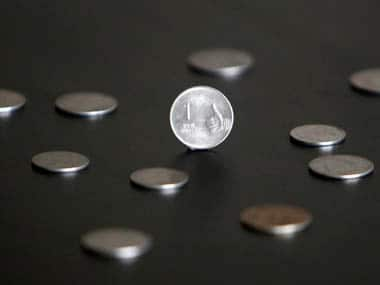The hue and cry over the rupee as it fell to record lows of 54 against the US dollar is even more than when India crashes out of a major cricket tournament. Calls for the Reserve Bank of India and the government to intervene to protect the rupee from falling further are almost as many as when angry fans are baying for the blood of cricketers, selectors and administrators.
What we must remember is that India eventually manages to make a comeback in cricket and it will do so in the case of its macro economic fundamentals as well, which will actually be helped by a weak rupee.
[caption id=“attachment_310771” align=“alignleft” width=“380” caption=“The reasons for the rupee’s fall include inflation, fiscal deficit, current account deficit and global risk aversion, all of which have been well documented by commentators. Reuters”]
 [/caption]
[/caption]
The reasons for the rupee’s fall include inflation, fiscal deficit, current account deficit and global risk aversion, all of which have been well documented by commentators. The rupee’s fall is based on fundamental factors and the government or the RBI cannot stem the fall in the short term. Heavy intervention by the RBI will only deplete a suddenly small looking bundle of foreign exchange reserves. India’s forex reserves of $293 billion is just enough to cover 7.7 months of imports as of December 2011, down from 11.1 months of imports at the end of March 2011. Short-term debt with residual maturity of less than one year accounts for over 43 percent of reserves, which exposes the country to ‘rollover’ risk. Using forex reserves to protect the rupee will be disastrous in the medium term.
The government cannot do anything, as it does not know what to do, apart from easing restrictions on foreign investments into the country. The government has already raised the debt investment limit by three times to $60 billion over the past few years. The government has allowed foreign nationals to invest in Indian equities, as well as backtracked on GAAR (General Anti Avoidance Rules). However, foreign institutional investors will come into the country only if they have risk appetite, and as of now, they do not have large risk appetite due to domestic as well as global fears such as the implications of a Greece debt default, a China slowdown, etc.
The natural course for the rupee is down and policy makers should let it follow its natural course. No country has ever been successful in preventing the course of a currency; India is no exception. Indians, be it news reporters, corporates, market participants or the average person on the street, should learn to deal with the rupee going down. If the markets want to take the INR down, it will do so, irrespective of egos and intervention.
And the Indian economy will learn to adjust to a new level of the rupee, although the adjustment will be painful for some and positive for others. The country has to remember that India’s rise in the IT outsourcing world was due to a weak rupee. Even after the rupee gained strength, India’s IT sector only marched forward, not backwards, as seen by the CAGR (compounded annual growth rate) growth of over 20 percent in revenues over the last 12 years.
Japan is one example where the strong currency is hurting the export-driven economy. The yen has gained 42 percent against the dollar and nearly 70 percent against the euro over the past four years. Exports contribute to 14 percent of GDP for Japan, and the strong Yen is hurting the country’s growth. The Bank of Japan (BOJ) has not intervened to protect the currency except for a brief period when the yen hit record levels of JPY 74 against the USD. BOJ has learnt its lessons from past interventions, which have largely been unsuccessful in taming a rising currency.
India, too, has to learn its lessons from a rupee that has fallen over 20 percent against the dollar in the past nine months. The first lesson is that markets will either embrace or distance itself from a country depending on sentiment, much like the Indian public worship or criticise a cricketing hero.
The second lesson is that India cannot jump about and shout that it is “a growing country with a young, large population”. Sound policies are a must to harness that potential and if policies are weak, the rupee will feel the effect. The third lesson is that ego has to be thrown away and work has to be done if the rupee is to get back its strength. Shouting from the rooftops that “it cannot happen to us” will do no good. It only exposes the country’s immaturity in handling markets.
Arjun Parthasarathy is editor of www.investorsareidiots.com , a web site for investors.
Arjun Parthasarathy has spent 20 years in the financial markets, having worked with Indian and multinational organisations. His last job was as head of fixed income at a mutual fund. An MBA from the University of Hull, he has managed portfolios independently and is currently the editor of www.investorsareidiots.com </a>. The website is for investors who want to invest in the right financial products at the right time.
)